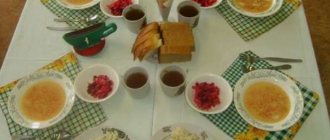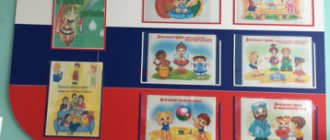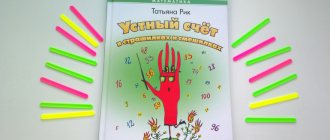MAGAZINE Preschooler.RF
"Organization of children's nutrition and the formation of aesthetic eating skills"Organizing meals in a preschool educational institution is a task of enormous social significance and one of the main concerns of the institution’s staff. At the same time, it matters not only what the child eats, but also how he does it. No less attention must be paid to the aesthetics of food and the culture of behavior of children at the table. And the sooner a child develops table etiquette skills, the more firmly they will become established and become a good habit already in childhood.
In the process of eating, the following cultural and hygienic skills are formed:
- wash your hands before eating;
- eat carefully;
- take as much bread as you can eat;
- eat in silence;
- chew with your mouth closed;
- use a napkin;
- sit correctly at the table;
- be able to handle a spoon, fork, table knife;
- Chew food thoroughly.
The transition of a skill into a habit is achieved by systematic repetition under the same or similar conditions. Until the habit is established, the child needs control and instructions from an adult, as well as encouragement, praise, and approval.
The professional duty of a preschool teacher is to teach the child table manners. This learning occurs both in specially organized classes and during meals. In the process of introducing a child to table etiquette, much attention is paid to the interaction of educators with parents. Coordinated action on this issue is of paramount importance. From an early age, it is necessary to develop in the child the correct attitude towards food, different dishes, and the ability to use cutlery and napkins.
However, mealtime should not be turned into a battleground for children's good manners. Good manners are acquired through repeated practice and also through the environment in which children constantly move. In this case, this environment is adults in a preschool. With a culture of food and communication, and goodwill, they create conditions through which good table manners are developed quickly enough and are learned by children for life.
The complexity of the tasks of developing cultural and hygienic skills occurs consistently and gradually, taking into account the age characteristics of the child.
1 ml. group (2 -3 years)
- develop the ability to use a spoon, teach yourself to eat a variety of foods, eat with bread, use a napkin after eating (first with the help of an adult, and then with verbal instructions), when leaving the table, push your chair in;
- consolidate the ability to wash your hands independently before eating, wipe your face and hands dry with a towel, eat neatly, and rinse your mouth when instructed by an adult;
- to develop the ability to follow the basic rules of cultural behavior: do not leave the table without finishing the meal, say . ”
2 ml. group (3 -4 years)
- teach how to wash your hands and face independently and carefully, use soap and a comb, wipe yourself dry after washing, hang a towel in its place;
- develop eating habits: do not crumble bread, use cutlery correctly (fork - from the second half of the year), napkin, rinse your mouth after eating.
middle group (4 -5 years old)
- improve acquired skills: chew food well, eat quietly, use cutlery (spoon, fork, knife), napkin correctly, rinse your mouth after eating.
senior group (5 -6 years old)
- strengthen the ability to properly use cutlery (fork, knife); eat carefully, quietly, maintaining correct posture at the table;
- continue to instill the skills of a culture of behavior: when leaving the table, quietly push the chair back, thank the adults.
preparatory group for school (6 -7 years old)
- consolidate table manners skills: sit up straight, do not put your elbows on the table, drink and chew food quietly, use a knife, fork, and napkin correctly; thank adults.
Methods and forms of organizing work with children:
- Visual (showing techniques for using cutlery, demonstrating serving rules, positive personal example, looking at pictures and illustrations, excursion to the catering department, observing peers)
- Verbal (explanation, clarification, persuasion, use of literary words, analysis of problem situations, encouraging assessment of the child’s activities)
- Practical (on duty, consolidating table manners, didactic games, story games)
Conditions for developing a positive attitude towards food (based on an individual approach and valeological education):
- convenient arrangement of tables, aesthetically pleasing serving and presentation of dishes;
- favorable psychological climate, friendly and attentive attitude of adults;
- explaining the need for rational nutrition, promoting a healthy lifestyle;
- exclusion of aggressive methods of influence (threats, coercion, punishment), it is undesirable to force a child to eat without appetite;
- gradually accustoming the child to the required norm in food (those children who are accustomed to eating only one dish at home (first or second) must be given an incomplete norm);
- providing assistance in feeding, while providing the opportunity to exercise independence (for children who do not have the ability to eat independently);
- allow children to wash down their food with compote, jelly, juice or just warm water - then they will eat willingly (for children who have difficulty swallowing food);
- During meals, it is advisable for the teacher to be at the table with the children.
The example of an adult is of great importance in working with children. Children feel the need for personal contact with adults and imitate their actions. Based on this, high demands are placed on the culture of each preschool educational institution employee.
Benefits of sharing meals between teacher and children:
- having breakfast and lunch with the children, the teacher demonstrates to them the beauty of etiquette, reasonableness and the need to observe it during the feast
— closer relationships arise between people eating together: the child perceives the teacher as part of a family community, trusts him and listens to his words.
Procedure for organizing meals:
- Preparing for meals. Compliance with hygienic requirements (furniture is arranged conveniently in accordance with the height of the children; tables are washed with hot water and soap. The teacher's assistant is obliged to thoroughly wash his hands, put on special clothing, ventilate the room, use only clean utensils)
- Hygiene procedures: valeological education of children, reinforcement of hand washing rules; competitive games (older age); self-control of children; performance assessment.
- Table setting: organization of duty; familiarization with the menu, announcing it to children; attracting children's attention to the aesthetic design of tables, maintaining correct posture.
- Meals (breakfast, lunch, afternoon snack, dinner). Individual work to develop a food culture; training in etiquette rules; performance assessment.
The kindergarten teacher is guided by the tasks formulated in the programs, but in order to trace the sequence and graduality of tasks for the formation of cultural and hygienic skills, in general, and the organization of duty in the dining room, in particular, it is necessary to take into account the age characteristics of children. So,
younger age:
- by the end of the year you can hang up the “Duty Board” and teach the children how to use it
- laying out spoons, napkin holders and bread bins on the table.
average age:
- table setting under adult supervision
- cleaning up used napkins
- stacking dirty dishes in the center of the table.
older age:
- table setting (independently under adult supervision)
- placing paper napkins in napkin holders (rolling into tubes, cutting, folding)
- cleaning up dirty dishes and used napkins.
Setting the table means preparing it for eating. The main purpose of table setting is to create order on the table and provide everyone with the necessary items. The serving order has been developed over the years, dictated by hygiene requirements and the need to provide the greatest convenience.
What is needed to set the table for a meal?
Proper table setting is a necessary condition for developing a positive attitude towards food and developing eating habits.
- lay a tablecloth on a clean table, its edges are lowered on all sides equally, but not lower than the seats of the chairs
- paper napkins are not laid out, but placed in a napkin holder (after finishing eating, first wipe your lips, then your hands, and place the used napkins on a dish)
- The bread bin is placed in the center of the table; if necessary, the bread is cut in half (does not break!)
- Cutlery is placed to the right of the plate: closer to the plate, a fork with the teeth up, next to it is a tablespoon with the indentation down (when eating soup, move the spoon away from you); if a table knife is served, then the fork is placed to the left of the plate, and the knife is placed on the right closer to the plate, with the blade facing the plate (meat, sausage, cheese, cucumbers, tomatoes, apples, pears are cut into small pieces with a knife. What is easy to cut with a fork is eaten without a knife: boiled potatoes, cutlets, casserole, omelette. In this case, the fork is held in the right hand, and the plate is held with the left: the thumb lies on the edge of the plate, the rest under the edge)
- if you serve compote with berries, then put a teaspoon on the saucer
- salad, sliced vegetables, marinade served in a separate plate
- All dishes are served according to the age norm.
| Next > |
Diet features
The diet should vary by season. In the off-season (spring, autumn) vegetables and fruits should prevail.
Meals in kindergartens are divided into periods:
- summer autumn;
- winter spring.
Children at an early age absolutely need to saturate their bodies with natural, healthy foods containing minerals, fiber, and vitamins. This is a building material - extremely necessary for the growth and development of every child. The inclusion of semi-finished products in the diet is unacceptable.
Menu for every day
The menu is approved by the head of the child care facility for 7 days. The composition of the products must comply with healthy nutrition standards. Meal regimen: 4 times a day, consisting of: breakfast, lunch, afternoon snack, dinner. Hot dishes, warm sandwiches and drinks are required for breakfast.
It is unacceptable to prepare dishes from the meat of wild poultry (animals) that have not undergone heat treatment. Harmful foods that should be excluded from the children's menu:
- unpasteurized milk;
- confectionery, cream;
- gas. beverages;
- natural coffe.
The responsibility of kindergarten management is to inform parents about the products included in children’s meals. It is important that from an early age a child learns to follow a diet in accordance with his age and time spent in a preschool educational institution. Example mode:
- breakfast – 8-9 am;
- lunch - 12-13 hours;
- afternoon tea - 15.30-16 hours;
- dinner 18.30-19.00.
At the discretion of the management, it is possible to assign 2 breakfasts from 10:30 to 11 o'clock.
Particular attention is paid to children - artificial children from 1 year:
- receiving nutrition from liquid and dry milk formulas;
- those suffering from food allergies, for whom the menu should be selected taking into account medical indications.
Parents should negotiate an acceptable diet with the management of kindergartens and create a menu together, taking into account the individual characteristics and intolerance of children with allergies. Rational nutrition is the key to excellent mental and physical development of children. Many programs have been developed for children with chronic internal diseases of the musculoskeletal system and digestive organs.
The organization of the diet should correspond to the energy needs of preschool children. The higher the training load, the more vitamins and micronutrients should predominate in the diet. A deficiency in the body is fraught with rapid fatigue, decreased performance, and children's stunted height and weight.
Nutrition is a building material for the formation of full growth and development of the child’s body. Protein (vegetable, animal) must be introduced into the body every day, otherwise violations of the immune system and brain are inevitable. But overfeeding children is also unacceptable. Excessive intake of fats and carbohydrates provokes metabolic failure and the development of serious chronic diseases.
We must not forget about maintaining a drinking regime for children. The intake of purified water per day should be at least 1.5 liters.
Principles of nutrition
The organization of proper nutrition in kindergarten is based on the following principles:
- full compliance with the energy value of the menu in relation to the energy consumption of children;
- maximum variety of dishes to ensure balanced nutrition for every day;
- compliance with the diet to develop food culture skills in children;
- strict compliance with the requirements for food preparation and technological processing, in accordance with established standards;
- maximum preservation of the nutritional value and taste of dishes after cooking.
Children spend most of their time in preschool educational institutions, so food should be varied, healthy, and tasty. Preschool children have an increased need to consume dishes made from dairy products, vegetables, fish, beef, and liver.
Particular attention is paid to sanitary standards, terms and conditions of storage of products. A monotonous menu in a preschool educational institution for 1 week is not acceptable. Dishes should not bore kids.





